Vamsikrishna Bhavana
March 2023
INTRODUCTION
Herbs are the major source of natural products used as pharmaceuticals, agrochemicals, flavoring agents, fragrants, ingredients in food additives and pesticides. There has been an explosion of scientific information concerning plants, crude plant extracts and various substances from plants as medical agents during the last few decades. Indian system of medicine has existed since extended period; however, the mechanism of plants as polyherbal formulations in treating ailments remains unexplored. This has prompted researchers to focus their investigations to understand the holistic information,especiallythe functional properties of such plants. Sustaining the nutritional requirements is one of the important tasks for any developing as well as developed countries. In resolving these combined factors, potential herbs should be identified, and their properties need to be evaluated.
Many herbs in current use have any one of the above resolving capacity. But from the traditional and scientific data available, legumes have promising potential sources in terms of nutrition, medicine, and agricultural development in developing countries. One such known legume is Mucuna pruriens. Its L-dopa content is scientifically proved to be highly effective in neurodegenerative disorders. It is also the best nutritional source as it contains rich nutrients especially protein and carbohydrates. Mucuna can be processed properly and can be utilized as the best nutrient and medicine. L- dopa isolated from Mucuna was found to be more effective than the synthetic product. Extracts of M. pruriens have been evaluated worldwide and concluded as a potential medicinal herb. In India, 15 species were identified and reported. Various works in taxonomical and nutritional characters on different geographical accessions were reported by 5 number of scientists. The herb is very much acceptable as livestock feed after removing the anti-nutritional Constituents.
TAXONOMY – THE GENUS AND SPECIES:
Mucuna pruriens is a tropical legume native to Africa and tropical Asia and widely naturalized and cultivated. Its English common namesinclude velvet bean, Bengal velvet bean, Florida velvet bean, Mauritius velvet bean, Yokohama velvet bean, cowage, cow itch, lacuna bean, and Lyon bean. The plant is notorious for the extreme itchiness it produces on contact, particularly with the young foliage and the seed pods. It has agricultural and horticultural value and is used in herbalism.
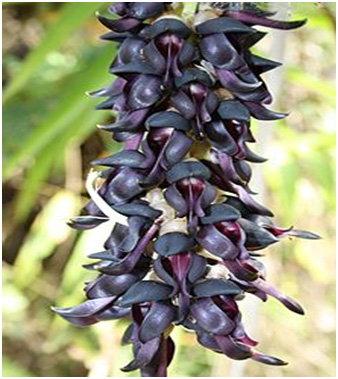
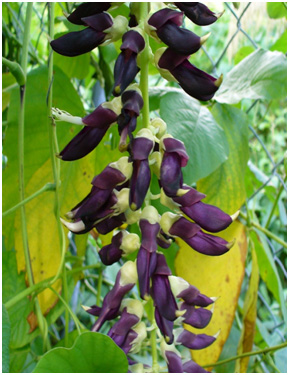
The plant is an annual climbing shrub with long vines that can reach over 15 meters (50 ft.) in length. When the plant is young, it is completely covered with fuzzy hairs, but when older, it is completely free of hairs. The leaves are trip innate, ovate, reverse ovate, rhombus-shaped or widely ovate.
In the fruit-ripening stage, a 4–13 centimeters (2–5 in) long, 1–2 centimeters (0.4–0.8 in) wide, unwinged, leguminous fruit develops. There is a ridge along the length of the fruit. The husk is very hairy and carries up to seven seeds. The seeds are flattened uniform ellipsoids, 1–1.9 centimeters (0.4–0.7 in) long, .8–1.3 centimeters (0.3–0.5 in) wide and 4–6.5 centimeters (2–3 in) thick. The hilum, the base of the funiculars (connection between placenta and plant seeds) is a surrounded by a significant arillus (fleshy seed shell).
M.pruriens bears white, lavender, or purple flowers. Its seed pods are about 10 cm (4 inches) long, and are covered in loose, orange hairs that cause a severe itch if they come in contact with skin. The itch is caused by a protein known as mountain. The seeds are shiny black or brown drift seeds. The dry weight of the seeds is 55–85 grams (2–3 oz.)/100 seeds.

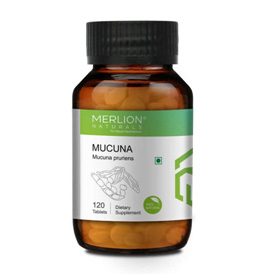
HISTORY AND ORIGIN:
- Mucuna pruriens belongs to the species fabaceae. Commonly known as cowage plant.
- It is a popular Indian medicinal plant, which has long been used from ancient period.
- The Ayurveda system of medicine is typically found in tropical regions and used for various purposes in traditional medicine in several countries.
- It is widespread over most of the subcontinent and found in forms of bushes, hedges, in dry deciduous low forest types throughout the plains of India.
- It grows naturally and is grown right from lower Himalayan range to entire tropical plains of India.
- The genus Mucuna consists of 100 species of climbing vines and shrubs.
- This is the second largest family of flowering plants and contains 600 genera and about 12000 species.
- The leaves are stipulated to nearly always alternate and range from bipinnately or palmate compound to simple and leaflets are 2-3 mm long.
- The petiole base is commonly enlarged into a pulvinus that Commonly functions in orientation of the leaves.
CLIMATE AND SOIL:
The stems of the leaflets are 2-3 mm long, and additional adjacent leaves present are about 5 mm long. The flower heads take the form of axially arrayed panicles.They are 15-32 cm long and have two to three or many flowers. The accompanying leaves are about 12.5 mm long, the flower stand axes are from 2.5 to 5 mm. The bell is 7.5-9 mm long and silky. The sepals are longer or of the same length as the shuttles. The crown is purplish or white. The flag is 1.5 mm long. The wings are 2.5-3.8 cm long. In the fruit ripening stage, a 4-13 cm long, 1-2 cm wide, unwinged, leguminous fruit develops. The husk is very hairy and carries up to seven seeds. The seeds are flattened uniform ellipsoid, 1-1.9 cm long, and 0.8-1.3 cm wide, and 4-6.5 cm thick.
PHYTO CHEMISTRY:
Seeds of velvet beans are known to produce the unusual nonprotein amino acid 3-(3,4- dihydroxyphenyl)-l-alanine The stems of the leaflets are 2-3 mm long, and additional adjacent leaves present are about 5 mm long. The flower heads take the form of axially arrayed panicles. They are 15-32 cm long and have two to three or many flowers. The accompanying leaves are about 12.5 mm long, the flower stand axes are from 2.5 to 5 mm. The bell is 7.5-9 mm long and silky. The sepals are longer or of the same length as the shuttles. The crown is purplish or white. The flag is 1.5 mm long. The wings are 2.5-3.8 cm long. In the fruit ripening stage, a 4-13 cm long, 1-2 cm wide, unwinged, leguminous fruit develops. The husk is very hairy and carries up to seven seeds. The seeds are flattened uniform ellipsoid, 1-1.9 cm long, 0.8-1.3 cm wide, and 4-6.5 cm thick. Seeds of velvet beans are known to produce the unusual nonprotein amino acid 3-(3,4- dihydroxyphenyl)-l-alanClimate and Soil.
The crop grows in all types of soils, but sandy loam soil with good drainage and pH between 5.50 to 7.50 is preferred.
It thrives in sub-tropical to tropical climate with a minimum temperature of 15°C in winter and maximum of 38°C in summer months.
The crop is seen growing in varied climate such as coastal humid climate to dry arid climate. Hence the crop is said to be highly acclimatizing and adaptive.
NUTRITIONAL CONSTITUENTS:
Mucuna forms a rich source of protein, carbohydrate, lipid, fiber, minerals, and amino acids. Crude protein (24 – 31.44 %), crude carbohydrate (42.79 – 64.88 %), crude lipid (4.1 – 14.39 %), crude fiber (5.3 – 11.5 %), ash (2.9 – 5.5 %)
minerals-806 – 2790 mg/100g for potassium, 4 – 70 mg/100g for sodium, 104 – 900 mg/100g for calcium, 98 – 498 mg/100g for phosphorus, 85 – 477 mg/100g for magnesium, 1.3 – 15 mg/100g for iron, 0.33 – 4.34 mg/100g for copper, 1 – 15 mg/100g for zinc and 0.56 – 9.26 mg/100g for manganese. Various amino acids were reported in various species of mucuna pruriens such as glutamic acid, aspartic acid, serine, threonine, proline, alanine, glycine, valine, cystine, methionine, isoleucine, leucine, tyrosine, phenyl alanine, tryptophan, lysine, histidine, and arginine supporting the genus for nutritional value.
PHARMACEUTICAL CONSTITUENTS:
Extract of the whole herb is reported to have L-dopa as a major constituent and in seeds18-19. Four alkaloids in Mucuna pruriens seeds were recently reported.
L- 3- caboxy- 1, 2, 3, 4- tetra hydro iso quinoline,
(-)- 1- methyl- 3carboxy- 6,
7- dihydroxy- 1, 2, 3, 4- tetrahydroisoquinoline,
dimethyl- 3carboxy- 6, 7- dihydroxy- 1,
2, 3, 4- tetrahydroisoquinoline and (-)- 1- 3- carboxy- 1,
1- dimethyl- 7, 8- dihydroxy- 1, 2, 3, 4- tetra hydroisoquinoline20.
Diversified chemical constituents in Mucuna seeds like, 5- hydroxytryptamine, 5-methoxy- N, N- dimethyltryptamine- N- oxide, 5- oxyindole- 3- alkylamine, 6- methoxyharman, arahidicacid, arginine, ash, asparticacid, behenicacid, betacarboline, betasitosterol, bufotenine, choline, cis- 12, 13- poxyctadec- trans- 9- cis- acid, cis- 12, 13- epoxyoctadec- trans- 9- enoicacid, gallicacid, glutamicacid, glutathione, indole- 3- alkylamine, linoleicacid, linoleicacid, mucunadine, mucunain, mucynine, myristic-acid, N, N- dimethyltryptamine, N, Ndimethyltryptamine, -N-oxide, niacin, nicotine, oleicacid, palmiticacid, prurienine, riboflavin, saponins, serotonin, stearicacid, thiamine, vernolicacid. In Mucuna leaves the data base reveals the presence of L-dopa, 6- methoxyharman, genistein, hydroxygenistein in minimal concentration. Recently three new lipid derivatives were also reported, triactont- 5, 7, 9- triene, docos- 2, 4, 6- triene- 1, 8- diol and docos- 5- en- 1- oic acid.
MEDICINAL VALUE:
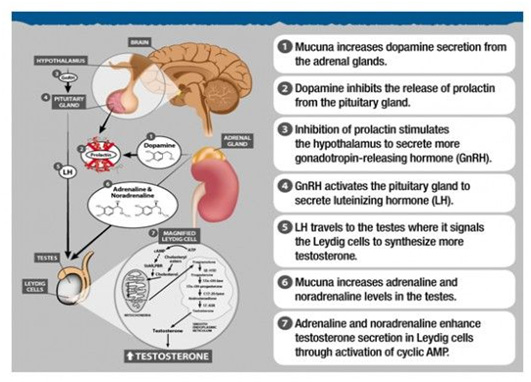
Many Mucuna species have been reported processing medicinal value apart from nutritional value and as fodder crop. The main use of this herb is to treat the symptomatic effects in Parkinson’s disease. The constituents bufotenine, choline, β-carboline were reported for their antiepileptic and antineoplastic activity. Mucuna birdwoodiana seeds are also used to treat joint pain and irregular menstruation. Mucuna pod hairs blended with honey can be used as vermifuge. Mucuna seed powder is used to treat leucorrhoea and spermatorrhoea. Seeds possess anabolic, androgenic, analgesic, anti-inflammatory, antispasmodic, antivenom, aphrodisiac, febrifuge, cholesterol lowering, hypoglycemic, immunomodulator, antilithiatic, antibacterial, antiparasitic, cough suppressant, blood purifier, carminative, hypotensive, and uterine stimulant properties.
All parts of M. pruriens possess valuable medicinal properties in traditional system of medicine in India and West Africa for example, M. Pruriens seeds, flowers and leaves are used against snake bites and used as a uterine stimulant and aphrodisiac. In Honduras, Central America, Africa and Guinea, this plant leaves are also used as food. Mucuna pruriens leaves are used in bone fractures, cough, dog-bite, madness, pain, pleuritis, ring worm, scorpion sting, snakebite, sores, and syphilis. They are used as an aphrodisiac, nerve tonic and in leucorrhea, spermatorrhea and applied to ulcers. The roots are said to be useful to cure cholera, elephantiasis, diuretic, and purgative. Mucuna pruriens is well known for producing itching. This property is attributed to the presence of 5-hydroxytryptamine (5-HT) in the hair on the pods. The plant has been studied for various activities like anti-diabetic, aphrodisiac, antineoplastic, antiepileptic, antimicrobial activities, learning and memory enhancement, antivenom, anthelmintic, and anti-inflammatory activities, The seeds have been reported to be antidiabetic, antifungal, antioxidant activity, hypotensive, hypocholesterolemia, hypothermic and antiparkinsonian activities, Abortion, alterative, anthelmintic, aphrodisiac, cancer, catarrh, immunomodulator , cough, debility, delirium, dropsy, dysentery, dysmenorrhea, emmenagogue, fertility, gout, impotency, irritant, lithiasis, nervine, night dreams, sterility, tuberculosis, uterine stimulant, worms. In Mucuna pruriens the Phytochemical screening has revealed the presence of alkaloids, reducing sugar, anthraquinones, flavonoids, saponins, tannins, cardiac glycosides, phenols, and steroids [5]. According to the Ayurveda M. pruriens roots are bitter, thermogenic, emollient, stimulant, purgative, aphrodisiac, diuretic, emmenagogue, anthelmintic, febrifuge, diuretic, and tonic. It is considered useful to relieve constipation, nephropathy, dysmenorrhea, amenorrhea, elephantiasis, dropsy, neuropathy, ulcers, helminthiasis, fever, and delirium. The M. pruriens seeds contain alkaloids, glycosides, reducing sugars, saponins, tannins, terpenoids, calcium, phosphorus and potassium, polyphenolic substances, protease inhibitor, phytic acid and L-dopa. The Mucuna pruriens seeds, pods and leaves are described as vermifuge. The seeds are used for human food and animal feed in Nigeria and one of the best sources of protein content. The seeds are astringent, laxative, anthelmintic, aphrodisiac and tonic. M. pruriens Seeds possess the activity of different aliments of anabolic, androgenic, analgesic, anti-inflammatory, antispasmodic, antivenom, aphrodisiac, febrifuge, cholesterol lowering, hypoglycemic, immune modulator, antilithiatic, antibacterial, antiparasitic, cough suppressant, blood purifier, carminative, hypotensive, and uterine stimulant properties [6]. Mucuna pruriens Leaves are useful in ulcers, inflammation, cephalalgia and general debility. Dried leaves of M. pruriens are sometimes smoked, an ointment prepared with hairs act as a local stimulant and mild vesicant.
ANTIVENOM ACTIVITY:
M. pruriens is one of the plants that have been shown to be active against snake venom and, indeed, its seeds are used in traditional medicine to prevent the toxic effects of snake bites, which are triggered by potent toxins such as neurotoxins, cardiotoxins, cytotoxins, phospholipase and proteases.
ANTIDIABETIC ACTIVITY:
The presence of these cyclitols is of interest due to the insulin mimetic effect of d-chiro-inositol, which constitutes a novel signaling system for the control of glucose metabolism. pruriens seeds are used at a dose of 500 mg/kg to reduce plasma glucose level. These and other data demonstrated that the number of seeds necessary to obtain a significant antidiabetic effect contain a total of approximately 7 mg of d-chiro-inositol. The antidiabetic properties of M. pruriens seed ethanol/water 1:1 extract isdue to d-chiroinositol and its galacto derivatives. The seed extract of M. pruriens at doses of 100 and 200 mg/kg body weight reduced oral glucose load from ~127 to 75 mg % after 2 h of oral administration. In another experiment, there was reduction of blood glucose from ~250 to 90 mg % in streptozotocin diabetic rats after 21 days. The investigation suggested that the antidiabetic activity may be due to its dietary fiber content.
ANTIPARKINSON’S ACTIVITY:
Parkinsonism is treated by the administration of powdered seed of M. pruriens containing 4 to 6% levodopa. Mucuna seed powder preparation has considerable faster action in treating PD patients than conventional standard drugs, namely,
Levodopa or Carbidopa and suggested that natural source of L-DOPA might possess advantages over conventional drugs in long term management of PD. M. pruriens cotyledon powder significantly increased the brain mitochondrial complex activity but did not affect the total monoamine Oxidase activity as having Nicotine adenine dinucleotide NADH) and coenzyme Q-10 in the cotyledon powder which are shown to have a therapeutic benefit in Parkinson‘s disease. Unlike synthetic levodopa treatment, M. pruriens cotyledon powder treatment significantly restored the levodopa, dopamine, and serotonin content in the substantianigra.
ANTIMICROBIAL ACTIVITY:
This research involves the study of antibacterial activity of root and seed of M. pruriens. The hexane, petroleum ether, benzene and aqueousextracts of root and seed were tested againstStaphylococcus aureus, Klebsiellapneumoniae,
Bacillus subtilis, Pseudomonas aeruginosa, Salmonella typhi and Escherichia coli using disc diffusion method. The methanolic extract showed high antibacterial activity against Erwiniacarotovora, Pseudomonas syringae, Pseudomonas marginalis, Pseudomonas acruginosa, Xanthomonascampestris and high anti-fungal activity against Curvularialunata, FusariumoxysporumPencilliumexpansum, Rhizoctoniasolani, Tiarosporellaphaseolina, Ustilagopomaydis
The results show that the extracts possess various degrees of significant inhibitory effect against the tested organisms.
ANTIBACTERIAL ACTIVITY:
Antibacterial activity of methanolic extract of Mucuna pruriens was evaluated and well documented the broad-spectrumactivity against Gram positive Bacillus cereus, Staphylococcus and Gram-negativeProteus vulgaris. The methanolic extract showed high antibacterial activity against Erwinia carotovora, Pseudomonas syringae, P. marginalis, P. acruginosa, Xanthomonas campestris.
EFFECT ON FERTILITY:
Mucuna pruriens improves male fertility by its action on the hypothalamus-pituitary-gonadal axis. M. pruriens significantly improved serum testosterone, luteinizing hormone, dopamine, adrenaline, and nor-adrenaline levels in infertile men and reduce the levels of follicle stimulating hormone (FSH) and prolactine hormone (PRL). Sperm count and motility were significantly recovered in infertile men [36]. The quality of seminal changes due to psychological stress was assessed after treating the case with M. pruriens seed powder at 5g/ day orally themethanolic extracts of M. pruriens significantly increased the relative weight of the testis, serum and testicular testosterone level, testicular cholesterol level, protein level in the testis.
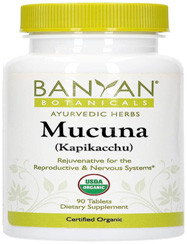
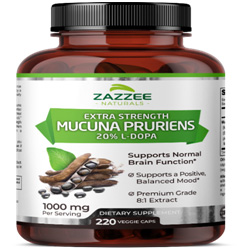
ANTI-DEPRESSANT ACTIVITY:
The anti-depressant activity by M. pruriens in acute and chronic models of depression was studied. Psycho-pharmacological investigation involved treatment (14 days) of M. pruriensin forced swim test (FST), tail suspension test (TST) in mice and olfactory bulbectomy in rats, respectively. With dose of Mucuna (10-20 mg/kg i.p.) significantly enhanced the anti-depressant action of fluoxetine and bupropion in mice FST and TST, respectively. Potentiation of 5-Hydroxytryptophan induced head twitches response (in mice) and reversal of reserpine induced hypothermia (rats) were observed at same dose level. Further, the behaviour anomalies exhibited by olfactory bulbectomised rats (OBX) were attenuated by chronic mucuna treatment as observed in open field.
ANTI-FUNGAL ACTIVITY:
High anti-fungal activity against Curvularia lunata, Fusarium oxysporum, Pencillium expansum, Rhizoctonia solani, Tiarosporella phaseolina, Ustilago pomaydis was shown by M. pruriens extracts. M. pruriens extracts possess various degrees of significant inhibitory effect against the tested organisms.
pruriens is reported to have the highest content of L-dopa. Mucuna is a good nutritional supplement.
`We find the phytochemical constituents and preparation various extracts of mucuna pruriens seeds, and comparison of antibacterial activity of the various extracts (aqueous extract and alcohol extract).
To evaluate the phytochemical screening and antibacterial activity of root and seed of Mucuna pruriens.
The preliminary phytochemical study of the extracts of root and seed of Mucuna pruriens revealed the presence of alkaloids, anthraquinones, flavonoids, phenols, tannins, terpenoids and xanthoprotein.
Drug profile
M. pruriens is a tropical twining herb commonly known as Velvet bean belonging to the family Fabeaceae. The plant is famous for the extreme itchiness it produces on contact, particularly with the young foliage and the seed pods due to the presence of protein, mucunain and serotonin [5- hydroxyltryptamine (5-HT)]. The beans of the M. pruriensare known to produce the unusual non protein amino acid L-dopa, a potent neurotransmitter.
Botanical Classification
Family : Fabaceae
Genus : Mucuna
Species : pruriens
Geographical source
Mucuna pruriens grows naturally in the humid tropical climates of the Caribbean& certain parts of China, India, Africa.
Macroscopic characteristics
Tate : sweetish bitter
Colour : Dark brown with spots
Odour : Not distinct
Shape : ovoid
Size : 1.2-1.8cm long 0.8-1.2cm width
Microscopic characteristics
A thin seedcoat and two hard cotyledas.
The outertestconsists of palisade cells.
Containing aleurone&starch grains. Starch grains-small, simple, rounded to oval.
Powder pale cream coloured.
Foreign matter: 1%
Moisture content: 3.8%
Ash content: 4.7%
The major chemical component in macula pruriens is.
L- DOPA.
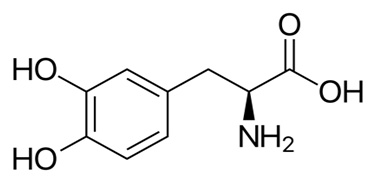
Taxonomy and Nomenclature
Latin Name : Mucuna pruriens
Synonyms : Carpopogon pruriens, Dolichos pruriens, Mucuna aterrima, M. atropurpurea, M. cochinchinensis, M. cyanosperma, M. deeringiana, M. esquirolii, M. prurita, M. utilis, Stizolobiumaterrimum, S. deeringianum, S. pruriens, S. pruritum, S. niveum, Negretia pruriens
Common names: Cowitch, Cowhage, Velvet Bean, Cow-itch, Buffalo bean velvet bean, mucuna, nescafe, podemico, fava-coceira, cabeca-de-frade, cowage, cowhage, cow-itch, bengal bean, mauritius bean, itchy bean, krame, picapica, chiporro, buffalo bean, Bengal velvet bean, Florida velvet bean, Mauritius velvet bean, Yokohama velvet bean, cowage, cowitch, lacuna bean, Lyon bean.
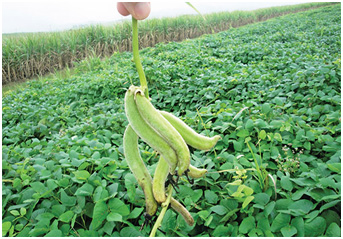
THERAPEUTIC USES OF M. PRURIENS:
M. pruriens cure night dreams, impotency and promote fertility, for sexual debility, seminal weakness and spermatorrhea, as an aphrodisiac to increase seminal fluid and manly vigour, emmenagogue, antivenin, nervine, for abortion, diarrhea, diabetes, gonorrhea, muscular pain, persistent coughs, pulmonary tuberculosis, rheumatic disorders, scorpion stings and snakebite, worm infestation, sterility and general debility.
According to Ayurveda, seeds are astringent, laxative, astringent, laxative, anthelmintic, aphrodisiac, alexipharmic and tonic. Seeds are found to have antidepressant properties in cases of depressive neurosis when consumed21and formulations of the seed powder have shown promise in the management and treatment of PD.
Seeds possess anabolic, androgenic, analgesic, anti-inflammatory, antispasmodic, antivenom, aphrodisiac, febrifuge, cholesterol lowering, hypoglycemic, immune modulator, antilithiatic, antibacterial, antiparasitic, cough suppressant, blood purifier, carminative, hypotensive, and uterine stimulant properties.
BENEFITS OF M. PRURIENS:
Improved sleep (promotes deep sleep) , reduced body fat & decreased cellulite , decreased wrinkles, improved skin texture & appearance, increased bone density and reversal of osteoporosis, increased lean muscle mass, improved mood and sense of well-being, enhanced libido & sexual performance, increased energy levels, improved cholesterol profile & regeneration of organs (heart, kidney, liver, lungs, dramatically strengthen immune system.
SIDE EFFECTS OF M. PRURIENS:
Increased serum levels of L-Dopa from consumption of Mucuna bean leads to high concentration of dopamine in peripheral tissues.
It induces antiphysiological effects such as nausea, vomiting, anorexia, paranoid delusions, hallucinations, delirium, and unmasking dementia.
The most common side effects found in the body are a sensation of abdominal bloating and nausea.
Other side effects observed during cowhage preparations include headache, pounding heartbeat, and symptoms of psychosis including confusion, agitation, hallucinations, and delusions.
The hair of the cowhage bean pod is a strong irritant and can cause severe itching, burning, and swelling if it is taken by mouth or applied to the skin.
Less common side effects include vomiting, abnormal body movements, and insomnia.
CONTRAINDICATIONS
The seed is a known teratogen and has uterine stimulant activity and should not be used during Pregnancy.
Velvet bean is contraindicated in combination with M.A.O. inhibitors.
Velvet beans have androgenic activity, increasing testosterone levels. Persons with excessive
Androgen syndromes should avoid using Velvet bean.
Velvet beans inhibit prolactin. If you have a medical condition resulting in inadequate levels of Prolactin in the body, do not use Velvet bean unless under the direction of your healthcare Practitioner.
The seed contains high quantities of L-dopa. Levodopa is the pharmaceutical medication used for Parkinson’s disease. Those with Parkinson’s should only use Velvet bean under the supervision of a qualified healthcare practitioner.
DRUG INTERACTIONS
May potentiate androgenic medications
May potentiate hypoglycemic medications.
May potentiate levodopa.
PREPARATION OF EXTRACTS:
PREPARATION OF ALCOHOL EXTRACT BY MACERATION PROCESS:
25gm seeds are weighed and kept in a hot air oven for one hour and powdered. The powder is transferred into a Round bottomed flask. And 100ml of alcohol was added to the powder. The RBF is kept aside for a week by stirring mixture of powdered drug and alcohol for every one hour now filter the solution after a week and store in refrigerator.
PREPARATION OF CHLOROFORM EXTRACT BY MACERATION PROCESS:
25gm seeds are weighed and kept in a hot air oven for one hour and powdered. The powder is transferred into a Round bottomed flask. And 100ml of chloroform was added to the powder. The RBF is kept aside for a week by stirring mixture of powdered drug and alcohol for every one hour now filter the solution after a week and store in refrigerator.
PREPARATION OF AQUEOUS EXTRACT BY USING SOXHLET APPARATUS:
The drug to be extracted in suitable committed form is usually packed in a thimble made of filter paper which is then placed into wider part of extraction. Thimble is used to prevent choking of the lower part of the extractor by the drug particles. Menstrum is placed on the flask and boiled the vapour are allowed to pass through the side lutre to the condenser where they are condensing and fall on to the packed drug, through which it percolates and extracts out the active constituents. As the volume of menstrum in the extractor increases the level of the liquid in the siphoned also increasing till it reaches the maximum point where it is siphoned on the flask. On further heating the menstrum vaporizes, while they dissolve active constituents remaining behind in the flask. The alternate filling and emptying of the body of the extractor goes on continuously till the drug is exhausted. Thus, the same quantity of the menstrum is made to percolate repeatedly about 14-15 times. Through the drug and active constituents are collected on the flask. These processes are not suitable for a drug containing thermo liable active constituents.
PROCEDURE FOR OBSERVING THE PHYTOCHEMICAL PROPERTIES OF MUCUNA PRURIENS SEEDS:
TEST FOR GLYCOSIDES: To the extract add aqueous NaOH. The formation of yellow color indicates the presence of glycosides.
TEST FOR FLAVONOIDS: To the 0.5ml of extract 5to10 drops of dilute Hcl and Zncl or magnesium were added. The presence of reddish pink or dirty brown color confirms the presence offlavonoids.
TEST FOR SAPONINS: To the 0.5ml extract a drop of sodium bi carbonate was added shaken vigorously. Appearance of fourth confirms presence of saponins.
TEST FOR STEROIDS: To 2ml chloroform extract 1ml of concentrated Sulphuryacid was added carefully along the slides of test tube Appearance of red color in the chloroform layer confirms steroids
TEST FOR CARBOHYDRATES:
MOLISCH’S TEST: To the extract added few drops of alcoholic alpha naphthol solution &few drops of Sulphuric acid was added along with the sides of the test tube Violet color at the junction of layers.
FELLING’S TEST: To the extract add equal amount of felling’s A&B solution and. The test tubewas kept in a water bath. Brick red precipitate of cuprous oxide formation confirms reducing sugars.
TEST FOR TANNINS AND PHENOLIC COMPOUNDS:
FERRIC CHLORIDE TEST: To the extract add ferric chloride. Greenish black color confirms presence of tannins.
POTASSIUM DI CHROMATE TEST: To the extract added potassium di chromate solution Formation of brown precipitate confirms presence of tannins.
OIL TEST: The extract is mixed with 1ml of 1% copper sulphate and 10% sodium Hydroxide. Blue color denotes the presence of oils.
PROCEDURE FOR OBSERVING ANTIMICROBIAL ACTIVITY:
PREPARATION OF STOCK SOLUTION: A standard solution of chloramphenicol was prepared by taking 1mg of chloramphenicol pure drug and dissolved in 1000ml of water. This is a stock solution of chloramphenicol.
From the above stock solution 10ml of the solution was pipetted out and 90ml of distilled water was added, then the concentration of the solution is 100μg/ml. From this solution 20, 40, 60, 80μg/ml solutions are prepared.
THE TEST SOLUTIONS OF DIFFERENT EXTRACTS: The test solutions of different extracts are prepared by taking 1ml of the extract dissolved in 1000ml of water, this is 1000μg/ml solution. From the above solution, 10ml of the solution is pipetted out and 90ml of distilled water is added, then the concentration is 100μg/ml. From this solution 20, 40, 60, 80μg/ml solutions are prepared.
MATERIALS USED:
Petri dishes
Inoculum loops
Graduated pipettes
Conical flask, glass rod, beakers.
Paper discs
Growth culture on nutrient agar medium.
PREPARATION OF NUTRIENT AGAR MEDIUM:
| S.NO. | Ingredients | Quantity |
| 1. | Beef extract | 3g |
| 2. | Peptone | 5g |
| 3. | Sodium chloride | 5g |
| 4. | Agar | 20g |
| 5. | Distilled water | 1000ml |
PH : 7.2-7.4
Nutrient agar medium is prepared by dissolving all these ingredients in water and the medium is subjected for sterilization using autoclave at 15lbs.pressure for 20mins and adjusted the pH 7.2 to 7.4.
METHOD OF TESTING:
The sterilized agar medium was transferred into clean and dry petri dishes and then allowed to solidify. After solidification, the growth culture is inoculated onto the petri dishes. The sterilized paper discs were dipped in the sample solution and carefully placed in the middle of the solidified medium. Then these petri dishes were kept for diffusion for 48 Hours at room temperature. After 48hours observe the petri dishes. The zone of inhibition was developed, and it was measured in millimeters.
RESULTS AND DISCUSSIONS
The following tests should be performed for phytochemical evaluation of mucuna pruriens seeds.
| S.NO | Name of the test | Observation | Inference |
| 1 | Test for glycosides | yellow color was obtained | Glycosides was present |
| 2 | Test for saponins | Appearance of forth | Saponins was present |
| 3 | Test for flavonoids | Presence of reddish pink or dirty brown color | Flavonoids was present |
| 4 | Test for steroids | Appearance of red color | Steroids was present |
| 5 | Test for carbohydrates (A) Molisch’s test(B) Fehling’s test |
(A) violet color ring was observed
(B) Brick red precipitate was observed |
carbohydrates were. present(B) Presence of Carbohydrates |
| 6 | Test for tannin and phenolic compounds Ferric chloride test Potassium di chromate test |
(A) No presence of greenish black color (B)No formation of brown precipitate |
(A)Absence of tannins.
(B)Absence of tannins |
The preliminary phytochemical study of the methanolic extracts of seed of Mucuna pruriens. Revealed the presence of alkaloids, anthraquinones, flavonoids, phenols, tannins, terpenoids and xanthoprotein.
| Presence and absence of bio active compounds | NAME OF THE EXTRACTS | ||
| Methanol | Water | Chloroform | |
| Alkaloids | + | – | + |
| Flavonoids | + | + | + |
| Phenols | + | + | + |
| Steroids | + | + | + |
| Sugar | – | + | + |
| Oils | – | + | + |
| Tannis | + | + | + |
| Xanthoprotein | – | – | + |
IN VITRO ANTIBACTERIAL EVALUATION OF MUCUNA PRURIENCE SEEDS
| S.NO | NAME OF EXTRACT | ZONE OF INHIBITION(MM) | ||
| PLANT PART AND ANTI-BIOTIC |
S. typhi | E. coli | ||
| 1 | AQUEOUS | AQUEOUS EXTRACT | 1 | 2 |
| TETRACYCLINE | 9 | 9 | ||
| CHLOROMPHENICOL | 9 | 8 | ||
| 2 | CHOLOROFORM | CHOLOROFORM EXTRACT | 1 | 1 |
| TETRACYCLINE | 9 | 9 | ||
| CHLOROMPHENICOL | 9 | 8 | ||
| 3 | METHANOL | METHANOL EXTRACT | 5 | 6 |
| TETRACYCLINE | 9 | 8 | ||
| CHLOROMPHENICOL | 8 | 9 | ||
1. Comparison the Aqueous Extract to Standard Anti-Bacterial Drugs
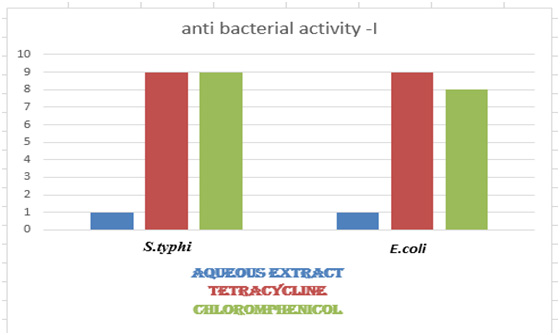
2. Comparison the Chloroform Extract to Standard Anti-Bacterial Drugs
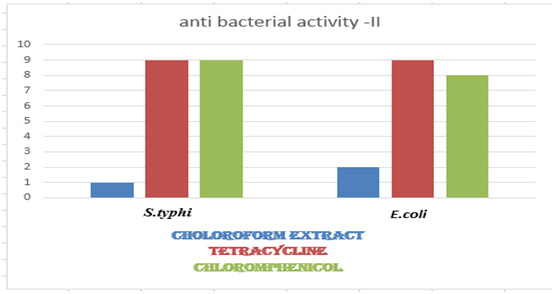
3. Comparison the Methanol Extract to Standard Anti-Bacterial Drugs
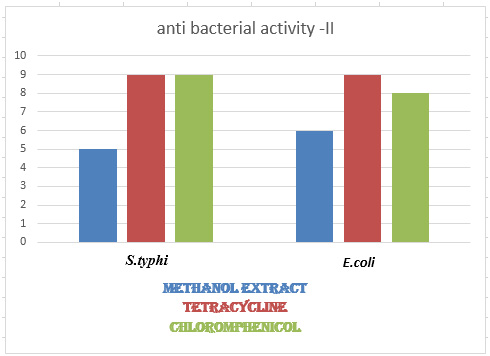
M.Purience methonolic extract exhibited the significant anti-bacterial effect against series of bacterial pathogens.among the various strains maximum anti-bacterial effect was recorded against S.aureus with 9 mm diameter of zone of inhibition was recorded against methanol extract of mucuna prurience s.aureeus recorded its second far most anti-bacterial sensitive ness to mucuna prurience with 9mm flowed by s.coli with 4.1 mm .the control agent chloramphenicol reflected its anti-bacterial effect against major tested pathogens
In the MIC assay M. pruriens methanol extract was screened against sensitive bacterial pathogens of E. coli, S. aureus, bacteria which exhibited maximum antibacterial effect in in-vitro assay M. pruriens extract of 10 µg – 250 µg was screened against four bacteria in using microliter plate and the bacterial growth inhibition was assessed using optical density measurement at 540 nm.
The results are promising enough that extract exhibits the maximum activity of MIC with the range of at 75- 80 µg/ml, S. aureus and E. coli on 175 µg/ml.
DISCUSSIONS:
In the present study alcoholic extract of M. pruriens seed extract in methanol and methanol was screened for its antibacterial effect against multi drug resistant human bacterial pathogens. Out of these two extracts methanol extract exhibited a significant antibacterial effect against S. Aureus reported that the methanol extract of Mucuna pruriens had significant in antimicrobial activity. The antibiotic sensitiveness of M. pruriens may be due to the immense phytochemicals present in the form of alkaloids and terpenoids. It is reported that M. pruriens consists of gallic acid and Bufotenine as its major Phyto constituents. These two alkaloids and tannin derivatives areexceptionally good antioxidants and antimicrobials in nature. Tannic acid, which is a mixture of Gallic acid esters of glucose can be used as a topical preparation for cold sores.
Many human physiological activities, such as stimulation of phagocytic cells, host mediated tumor activity, and a wide range of anti-infective actions, have been assigned to tannins. One of their molecular actions is too complex with proteins through so-called nonspecific forces such as hydrogen bonding and hydrophobic effects, as well as by covalent bond formation. Thus, their mode of antimicrobial action may be related to their ability to inactivate microbial adhesions, enzymes, and cell envelope transport proteins, they also complex with polysaccharide. This explains the reason as to why the plants containing these tannins showed good antibacterial activity. Mucuna pruriens seed was an effective antimicrobial agent to treat bacterial infection, apart from their roles as food additives and supplements. It can also be utilized as an effective and cheap source of antimicrobial agent.
Mucuna pruriens methanol extract was found to be more effective in inhibiting the pathogens compared to ethanol and acetone extracts. The study showed that M. pruriens methanolic seed extract exhibited a significant antibacterial effect against the four bacterial species: E. coli and S. aureus. The active compounds in these plants should be traced out which could find place in the treatment of various bacterial infections where they can be used as alternatives to conventional antibacterial drugs. This could reduce the unnecessary use of antibiotics, which is making disease causing bacteria more resistant to the drugs and diminishing the drug’s power to treat life threatening disease in humans and animals.
CONCLUSION
The study has been able to establish and document the importance of M. pruriens seed extract in the management of bacterial diseases. The seed extract shows a broad spectrum of antibacterial activity against pathogenic bacteria. This indicates that M. pruriens seed extract has the capability to solve some of the problems caused by bacteria and this seed extract is used to treat a number of bacterial diseases.
The results suggest that extracts of Mucuna pruriens seed phytochemicals have an antibacterial effect may be used along with feed to manage the vibriosis. However, further investigation is required to isolate the active compounds responsible for antibacterial activity. These will serve as lead compounds in the manufacture of novel drugs which can use as one of the approaches in the prevention and control of diseases.
REFERENCES
- Lampariello LR, Alessio CortelazzoA, Guerranti R,Sticozzi C, Valacchi G. The Magic Velvet Bean of Mucuna pruriens. Journal of Traditional and Complementary Medicine 2012; 2(4):331-339
- Natarajan K, Narayanan N, Ravichandran N. Review on “MUCUNA” – The Wonder Plant. Int J Pharm Sci Rev Res 2012; 17(1):nᵒ18, 86-93
- Abiramasundari P, Priya V, Jeyanthi GP, Gayathri Devi S.Evaluation of the Antibacterial activity of Cocculus hirsutus. Hygeia. J.D. Med 2011; 3(2):26-31
- Gislene GFN, Locatelli J, Paulo C, Freitas PC, Giuliana LS. Antibacterial activity of plant extracts and phytochemicals on antibiotic resistant bacteria. Brazilian Journal of Microbiology 2000; 31:247-256.
- Marimuthu M, Uma Sundaram, P. Gurumoorthi. Comparative Phytochemical Evaluation and Antibacterial Activity of Two Different Germplasm of Mucuna. Int J Pharm Pharm Sci 2013; 5(2):46-51.
- Bauer AW, Kirby WMM, Sherries SC, Turk M. Antibiotic susceptibility of testing by a standard single disc method. Amer. J. Clinical. Pathol 1966; 36:492-496.
- Eloff JN. A sensitive and quick microplate method to determine the minimal inhibitory concentration of plant extracts for bacteria. Planta Med 1998; 64:711-713.
- NCCLS. Methods for dilution antimicrobial susceptibility tests for bacteria that grow aerobically: Approved standard Fifth edition, NCCLS dominant M1745; NCCLS, Wayne, PA. USA, 2000,
- Rajeshwar Y, Gupta M, Mazumder UK in Vitro Lipid Peroxidation and Antimicrobial Activity of Mucuna
pruriens Seeds. Iranian Journal of pharmacology and therapeutics 2005; 4(1):32-35. - Kumar P, Saha S. An updated review on Taxonomy, Phytochemistry, Pharmacology and Toxicology of
Mucuna pruriens. Journal of Pharmacognosy and Phytochemistry 2013; 2(1):306-314.
